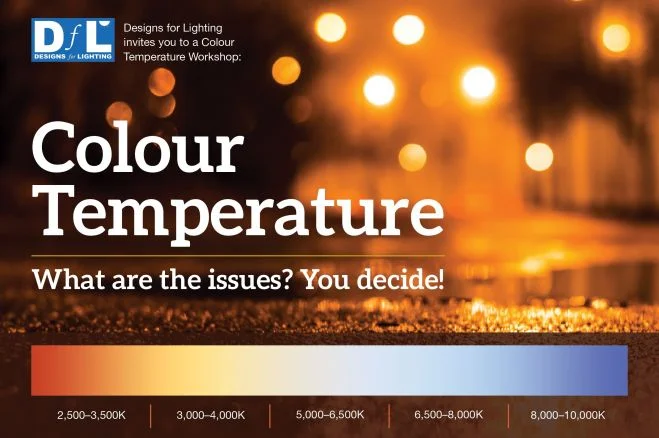Alistair Scott-MD and Ryan Carroll-Lighting Designer of DfL sum up the latest results from their series of workshops on this hot topic.
For the past few years the Lighting Industry has been concerned with the poor quality of light produced by some LED street lighting products and installations. Many early LED replacement schemes focused purely on energy savings. They didn’t always consider quality of light and the needs of their residents. We’ve heard of many instances of residents complaining about poor street lighting. In particular complaints relating to high colour temperature which can produce a cold, harsh effect on the streets. Light sources with higher proportions of blue light (typically those with Correlated Colour Temperature (CCT) > 4000K) cause particular concern on potential health implications.
The British Standard for Road Lighting, BS5489-1 is not specific on colour temperature as any specification would need to be evidence based. Higher colour temperature light sources tend to have higher S/P (scotopic / photopic) ratios which help to provide energy efficiency benefits. Various public health-related reports have come out of the US and UK which relate to health concerns. Many are unproven but some bear scrutiny and the need for debate.
The recently published Public Health England report (‘Human Responses to Lighting based on LED Lighting Solutions’) urges us to use lower colour temperatures where possible (Page 18 section 5.2)
At DfL we’ve researched into the performance of different colour temperature LED light sources. We conclude that the efficiency of warmer colour temperatures is improving in relation to cooler colour temperatures, with a reduced efficiency gap of around 10% lower for warmer temperatures.
We wanted to research the opinions of the lighting profession. We included differences in performance between warmer and cooler colour temperatures and user preferences based on both aesthetics and technical merits.
We’ve conducted interactive workshops in ILP regions at Nailsea, Wigan, Northampton (Lightscene), Edinburgh and London. Audiences comprised of Local Authorities, contractors, consultants and manufacturers. We also presented a workshop at the Professional Lighting Summit in Glasgow (June 2017).
Ryan sums up the results
“Feedback from the workshops show a definite trend in preference of light sources with CCT of 3000k over 4000K. Many lighting professionals prefer 4000K for cost and energy saving but 3000K for aesthetics and visual appearance.”
Alistair adds his thoughts,
’This is interesting, as it’s a subject where many engineers have entrenched views. Our aim is to challenge these views and consider specifying warmer colour temperatures. This in turn will inform updates to relevant British Standards and our approach to specifying colour temperature in street lighting.’























